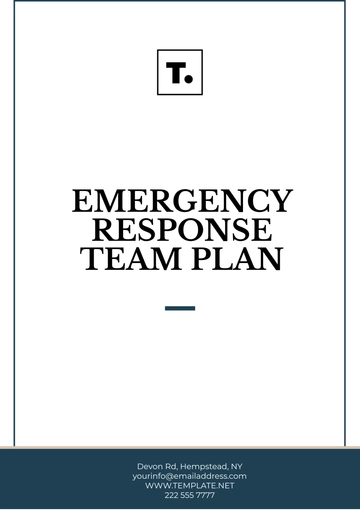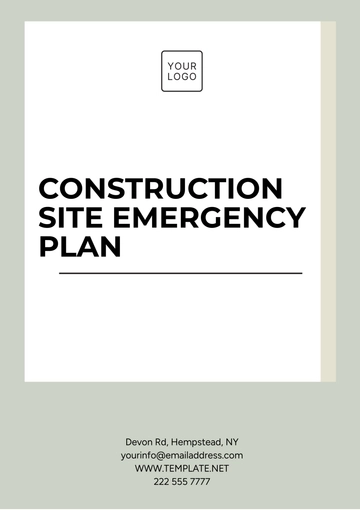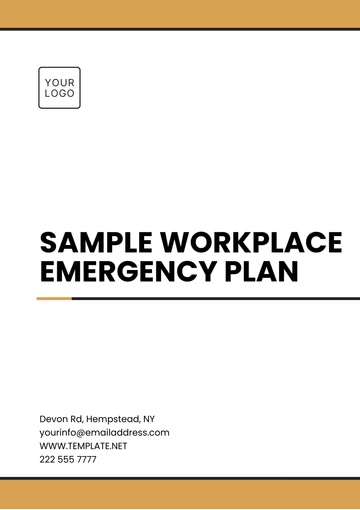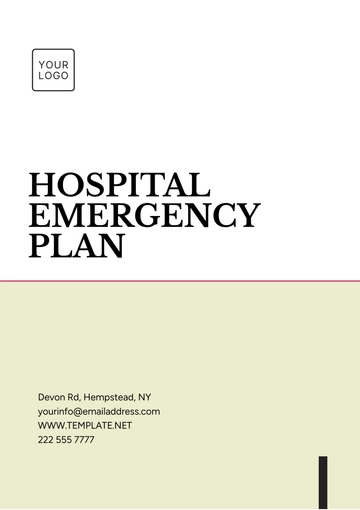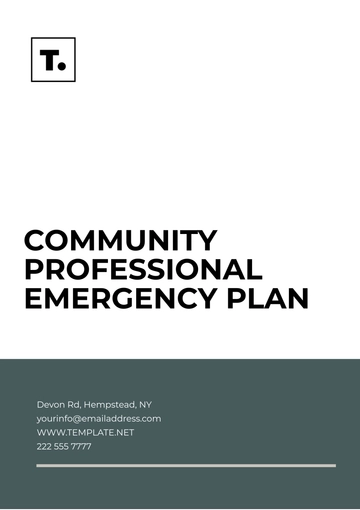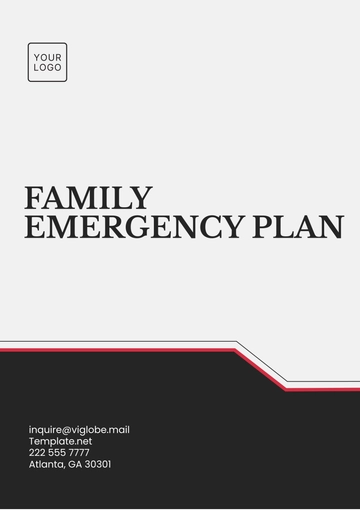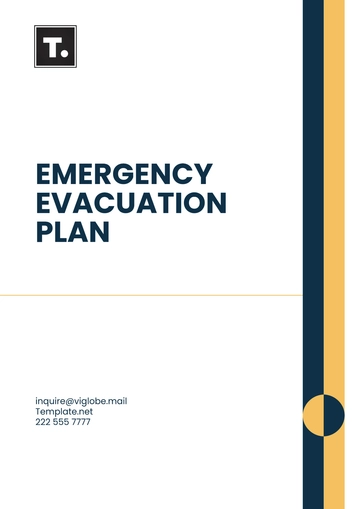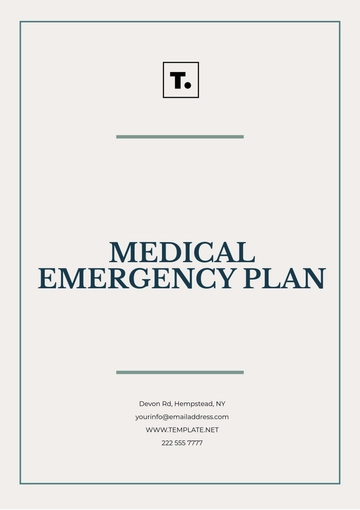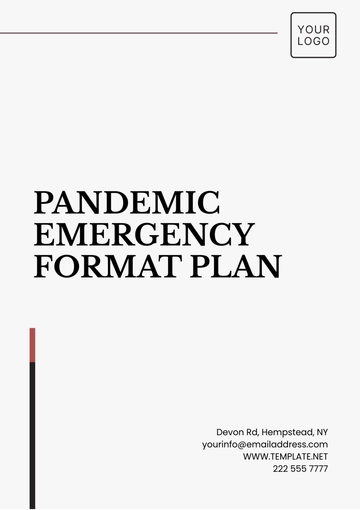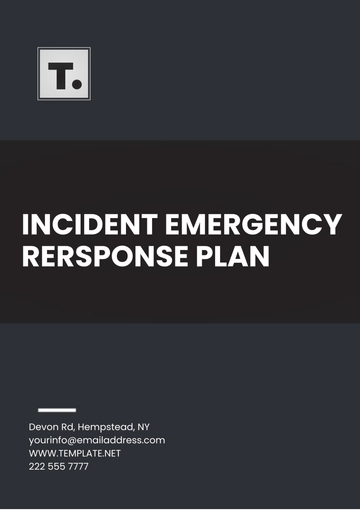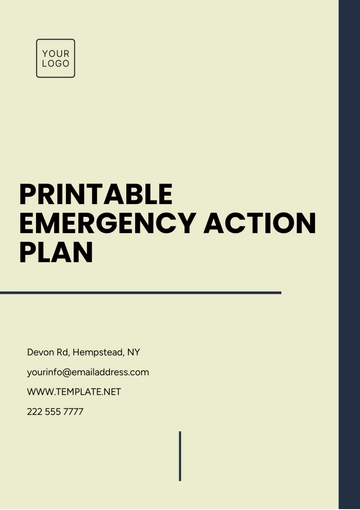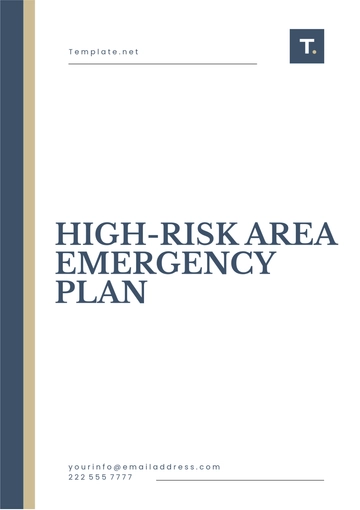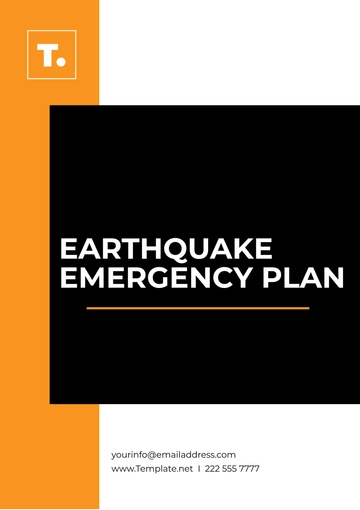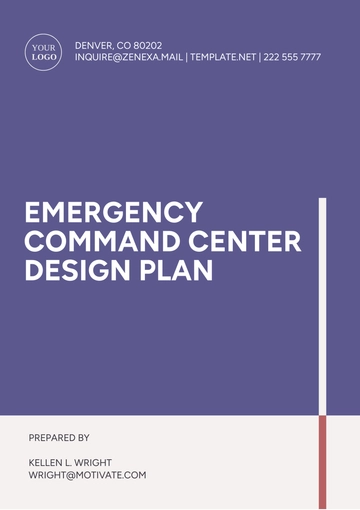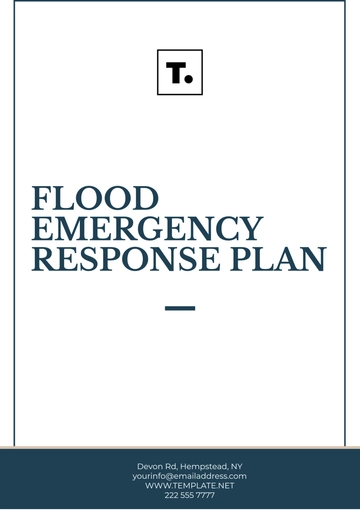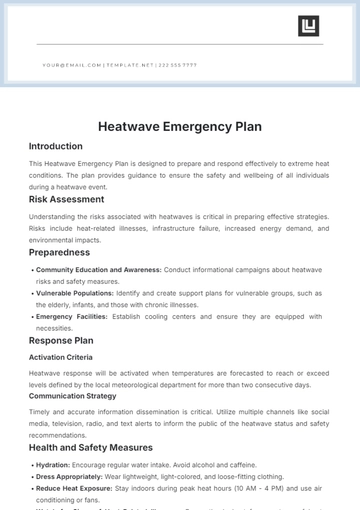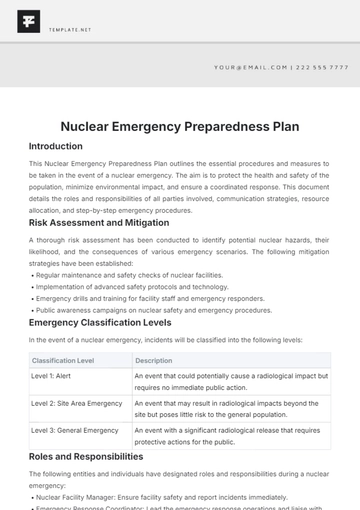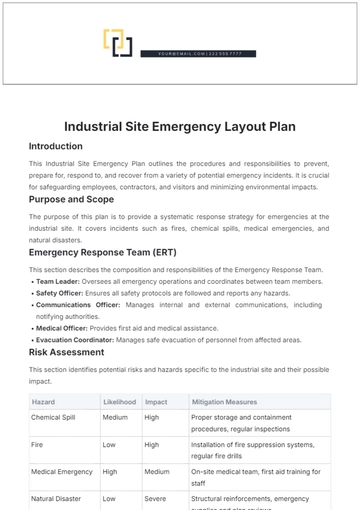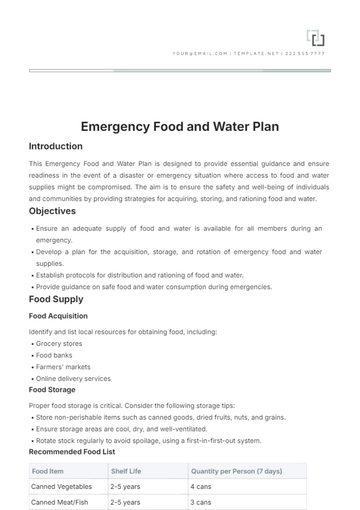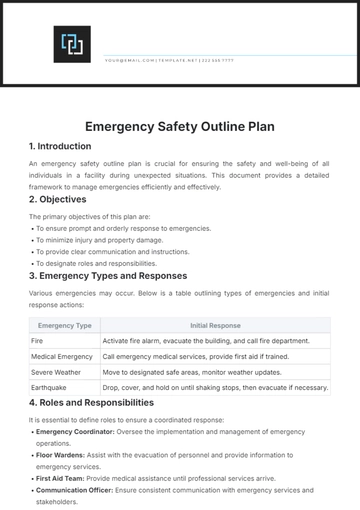Free Cleaning Services Emergency Evacuation Plan
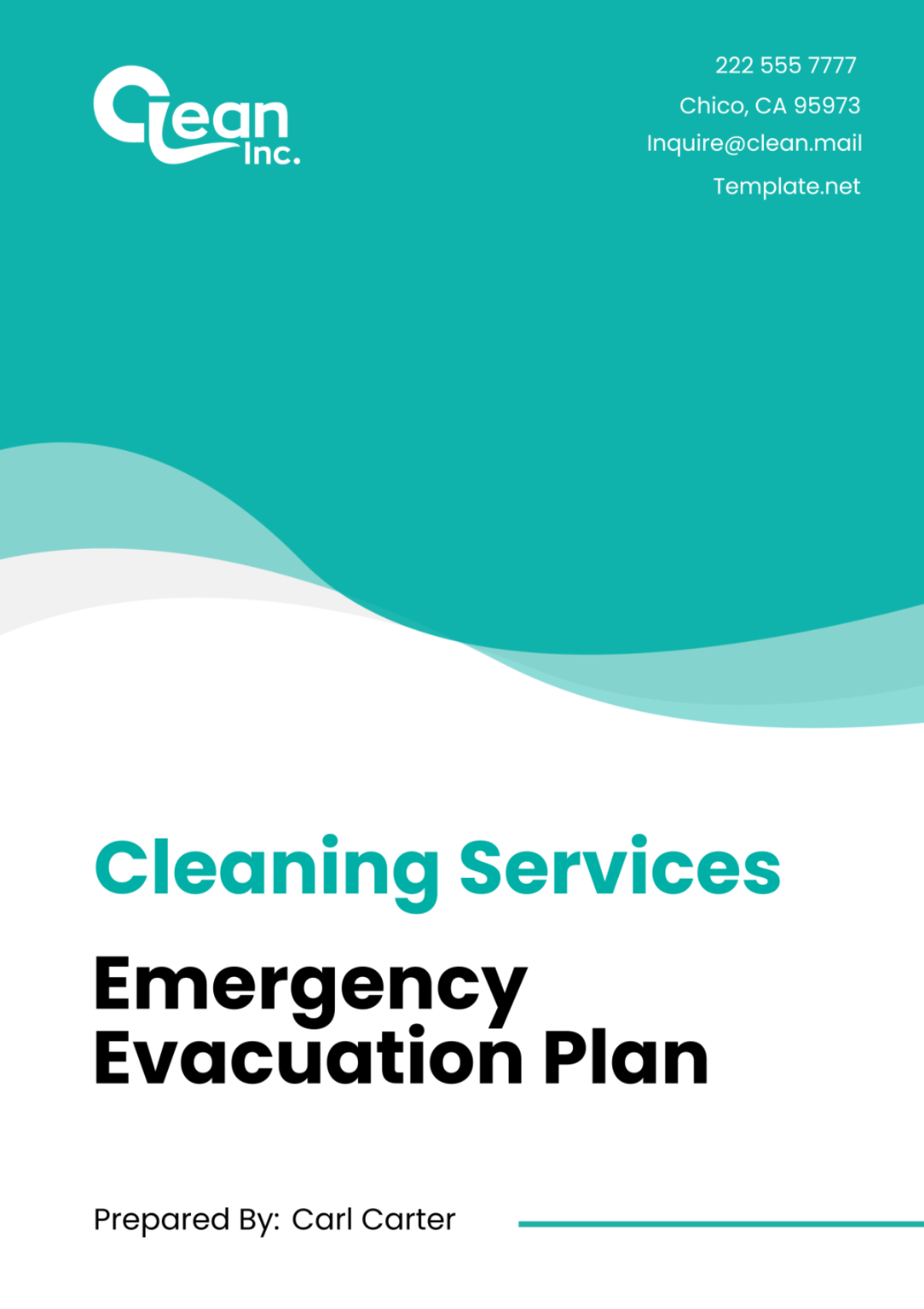
I. Introduction
At [Your Company Name], the safety and security of our employees, clients, and visitors are paramount. We recognize the importance of being prepared for emergencies and ensuring everyone's well-being in such situations. This Emergency Evacuation Plan serves as a comprehensive guide outlining procedures to be followed in the event of an emergency necessitating evacuation within our cleaning services establishment.
II. Emergency Contacts
In the event of an emergency, immediate communication with the appropriate authorities is vital. Below are the essential emergency contact numbers:
Fire Department: [Fire Department Number]
Police Department: [Police Department Number]
Medical Facilities: [Hospital/Clinic Number]
Company Emergency Contact: [Company Emergency Number]
Ensure all employees are aware of these contact numbers and understand when and how to utilize them during an emergency.
III. Evacuation Routes
Safe evacuation routes are critical for ensuring the swift and orderly evacuation of individuals during emergencies. Please familiarize yourself with the following evacuation routes:
Main Exit: The primary evacuation route directs individuals to exit through the main entrance/exit located at the front of the building. This route leads directly to [Assembly Point 1] located in the parking lot adjacent to the building.
Secondary Exit: In case the main exit is obstructed or inaccessible, the secondary evacuation route guides individuals to exit through the emergency exit door located at the rear of the building, near the break room area. This route leads to [Assembly Point 2] situated on the sidewalk behind the building.
Emergency Exits: Additional emergency exits are strategically located throughout the building to provide alternative evacuation options. These exits are clearly marked with illuminated exit signs and are accessible via stairwells on each floor, corridors leading to the nearest exit door, or designated emergency exit routes clearly indicated by signage.
Evacuation Map: A comprehensive evacuation map, prominently displayed in various areas of the building, illustrates all primary and secondary evacuation routes, as well as the locations of emergency exits and assembly points. Employees are encouraged to familiarize themselves with this map to ensure a swift and orderly evacuation in the event of an emergency.
Regular review and practice of evacuation procedures with all employees are essential to ensure they are familiar with evacuation routes and assembly points.
IV. Assembly Points
In the event of an emergency evacuation, designated assembly points have been established to ensure the safe gathering and accountability of all individuals. Please adhere to the following assembly point procedures:
Primary Assembly Point: The primary assembly point is situated in the parking lot directly in front of the main entrance/exit of the building. Upon exiting the premises, employees and clients/customers should proceed to this designated area and await further instructions.
Secondary Assembly Point: In the event that the primary assembly point is inaccessible or compromised, the secondary assembly point is located in the grassy area adjacent to the employee parking lot on the southwest corner of the building. This secondary location provides an alternative gathering point to ensure the safety and accountability of all individuals.
Headcount and Accountability: Upon reaching the assembly point, designated personnel will conduct a thorough headcount to ensure that all employees, clients/customers, and visitors have safely evacuated the premises. It is imperative that all individuals remain at the assembly point until further instructions are provided by emergency responders or designated company personnel.
Communication at Assembly Points: Clear communication channels will be established at each assembly point to relay important information and updates regarding the emergency situation. Designated personnel will provide instructions and guidance to ensure that all individuals remain informed and safe during the evacuation process.
Regular drills and training sessions will be conducted to familiarize employees and clients/customers with the locations of assembly points and the procedures to follow in the event of an emergency evacuation. These measures are essential for maintaining the safety and well-being of everyone within the premises.
V. Communication Protocols
Effective communication is essential for ensuring the safety and well-being of all individuals during emergency situations. The following communication protocols have been established:
Alert System Activation: In the event of an emergency, the alert system will be activated to immediately notify all employees, clients/customers, and visitors of the situation. The alert system may include audible alarms, visual notifications, and electronic messages sent via email or text message.
Emergency Announcement: Following the activation of the alert system, an emergency announcement will be made over the public address (PA) system. This announcement will provide clear and concise instructions regarding the nature of the emergency, evacuation procedures, and the location of assembly points.
Designated Communicators: Designated individuals, such as members of the emergency response team or trained safety personnel, will be responsible for relaying information to employees, clients/customers, and visitors. These communicators will serve as points of contact for receiving updates on the situation and disseminating important information as necessary.
Two-Way Communication: Two-way communication channels will be established to allow for the exchange of information between individuals at assembly points and designated personnel. This may include handheld radios, mobile phones, or other communication devices capable of transmitting messages reliably.
Updates and Notifications: Regular updates and notifications will be provided to keep everyone informed of developments during the emergency. This may include updates on evacuation progress, changes to evacuation routes or assembly points, and any additional instructions from emergency responders or management.
VI. Training and Drills
Regular training sessions and evacuation drills are integral to ensuring that all employees are adequately prepared to respond effectively in the event of an emergency. The following comprehensive approach to training and drills will be implemented:
Evacuation Procedures Training: All employees will receive thorough training on evacuation procedures, including the identification of primary and secondary evacuation routes, the location of assembly points, and the proper use of emergency equipment such as fire extinguishers and emergency alarms. Training sessions will be conducted upon initial employment and will be repeated annually or as needed to reinforce understanding and compliance.
Role Assignments: During training sessions, specific roles and responsibilities will be assigned to designated employees to ensure a coordinated response to emergencies. These roles may include evacuation team leaders, first aid responders, communication coordinators, and individuals responsible for assisting individuals with disabilities or special needs. Employees will be trained to fulfill their assigned roles effectively and to collaborate with others to ensure a smooth evacuation process.
Simulated Emergency Scenarios: Regular drills will be conducted to simulate various emergency scenarios, such as fires, natural disasters, or hazardous material spills. These drills will provide employees with practical experience in responding to emergencies and will help to identify areas for improvement in evacuation procedures, communication protocols, and coordination among team members. Feedback and lessons learned from each drill will be used to refine the Emergency Evacuation Plan and enhance overall emergency preparedness.
Review of Emergency Procedures: Following each training session and drill, a debriefing session will be conducted to review the effectiveness of emergency procedures and identify any areas for improvement. Employees will have the opportunity to provide feedback and suggestions for enhancing emergency preparedness, which will be incorporated into future training sessions and drills.
Documentation and Record Keeping: Records will be maintained documenting employee participation in training sessions and drills, as well as any observations or feedback provided during debriefing sessions. These records will serve as evidence of compliance with training requirements and will help to track progress in emergency preparedness over time.
VII. Review and Revision
This Emergency Evacuation Plan will be reviewed and updated regularly to ensure it remains current and effective. Reviews will include:
Annual Review: A comprehensive review of the plan will be conducted annually to assess its effectiveness and make any necessary revisions.
Incident Analysis: Any emergency incidents will be analyzed to identify lessons learned and implement improvements to the evacuation plan.
Employee Feedback: Input from employees will be solicited to identify areas for improvement and address any concerns regarding emergency preparedness.
By regularly reviewing and updating the Emergency Evacuation Plan, we can ensure that [Your Company Name] remains prepared to respond effectively to any emergency situation.
VIII. Special Considerations
Recognizing the diverse needs of individuals within our establishment, special considerations have been incorporated into our Emergency Evacuation Plan to ensure the safety and well-being of everyone, including those with disabilities or special requirements. The following comprehensive measures have been implemented:
Identification and Documentation: Employees with disabilities or special requirements will be identified, and their specific needs documented in a confidential registry. This registry will include information such as mobility limitations, sensory impairments, medical conditions, or other factors that may impact their ability to evacuate safely.
Personalized Emergency Plans: Individualized emergency plans will be developed for employees with disabilities or special requirements, outlining specific evacuation procedures tailored to their needs. These plans will include alternative evacuation routes, designated evacuation assistants, and any necessary accommodations or equipment to facilitate safe evacuation.
Training and Awareness: Employees will receive specialized training on assisting individuals with disabilities or special requirements during evacuations. This training will include techniques for providing physical assistance, communication strategies, and protocols for using specialized equipment such as evacuation chairs or mobility aids.
Evacuation Assistance Team: A designated Evacuation Assistance Team will be established, consisting of trained volunteers who are responsible for assisting individuals with disabilities or special requirements during evacuations. These volunteers will receive advanced training on evacuation procedures and will be equipped with the necessary knowledge and resources to provide assistance effectively.
Communication and Support: Clear communication channels will be established to ensure that individuals with disabilities or special requirements are informed and supported throughout the evacuation process. Designated personnel will be available to provide assistance, answer questions, and address any concerns or needs that arise during evacuations.
IX. Hazards Identification
Identifying and mitigating potential hazards within our cleaning services establishment is critical to minimizing risks and ensuring the safety of all individuals in the event of an emergency. The following comprehensive approach to hazards identification and mitigation has been implemented:
Risk Assessment: Regular comprehensive risk assessments are conducted to identify potential hazards associated with our operations, facilities, equipment, and materials. These assessments consider factors such as fire hazards, structural vulnerabilities, hazardous materials, electrical risks, and natural disaster vulnerabilities.
Hazard Mitigation Measures: Based on the findings of risk assessments, appropriate hazard mitigation measures are implemented to reduce or eliminate identified risks. These measures may include implementing engineering controls (such as fire suppression systems or structural reinforcements), administrative controls (such as implementing safety protocols or restricting access to hazardous areas), or personal protective equipment (such as gloves, goggles, or respirators).
Emergency Response Plans: Specific emergency response plans are developed for addressing different types of hazards and emergencies identified during the risk assessment process. These plans outline procedures for responding to fires, chemical spills, natural disasters, medical emergencies, and other potential hazards, including evacuation procedures, communication protocols, and coordination with emergency responders.
Employee Training: All employees receive comprehensive training on hazard identification, emergency response procedures, and the proper use of safety equipment. Training sessions cover topics such as recognizing potential hazards, responding to emergencies, and reporting safety concerns. Regular drills and exercises are conducted to reinforce training and ensure that employees are prepared to respond effectively to emergencies.
Continuous Monitoring and Improvement: Hazard identification and mitigation efforts are ongoing processes that require continuous monitoring and evaluation. Regular inspections, audits, and reviews are conducted to assess the effectiveness of hazard controls and identify any new or emerging hazards. Feedback from employees, incident investigations, and lessons learned from emergency events are used to continually improve our hazard identification and mitigation efforts.
X. Conclusion
The safety and well-being of our employees, clients, and customers are non-negotiable priorities for [Your Company Name]. By implementing and regularly reviewing this Emergency Evacuation Plan, we are committed to ensuring that everyone in our establishment can respond effectively to emergencies and evacuate safely. Continuous training, communication, and preparedness will remain central to our efforts to maintain a safe and secure environment for all.
XI. Appendix
These documents and resources play a crucial role in ensuring the effectiveness of emergency preparedness and response efforts within [Your Company Name]. Regular review and updates of these materials are essential to maintain readiness and ensure the safety of all individuals in the event of an emergency.
Evacuation Maps: Detailed visual guides outlining evacuation routes and assembly points within the premises.
Employee Contact List: Comprehensive record containing names and contact information of all employees for communication purposes during emergencies.
Emergency Contact List: Compiled directory of essential emergency contact numbers including fire departments, police stations, and medical facilities.
Safety Procedures Manual: Document detailing protocols and guidelines for responding to various emergency situations, ensuring uniformity in response efforts.
Training Records: Records documenting employees' participation in emergency preparedness training sessions and drills, aiding in assessing readiness and identifying areas for improvement.
- 100% Customizable, free editor
- Access 1 Million+ Templates, photo’s & graphics
- Download or share as a template
- Click and replace photos, graphics, text, backgrounds
- Resize, crop, AI write & more
- Access advanced editor
Ensure the safety of your cleaning services team with Template.net's Emergency Evacuation Plan Template. Customizable in our AI Editor Tool, this easily editable template provides a strategic blueprint for swift and orderly evacuation procedures. Safeguard your staff and clients in unforeseen circumstances. Elevate your emergency preparedness and ensure peace of mind with Template.net!
You may also like
- Finance Plan
- Construction Plan
- Sales Plan
- Development Plan
- Career Plan
- Budget Plan
- HR Plan
- Education Plan
- Transition Plan
- Work Plan
- Training Plan
- Communication Plan
- Operation Plan
- Health And Safety Plan
- Strategy Plan
- Professional Development Plan
- Advertising Plan
- Risk Management Plan
- Restaurant Plan
- School Plan
- Nursing Home Patient Care Plan
- Nursing Care Plan
- Plan Event
- Startup Plan
- Social Media Plan
- Staffing Plan
- Annual Plan
- Content Plan
- Payment Plan
- Implementation Plan
- Hotel Plan
- Workout Plan
- Accounting Plan
- Campaign Plan
- Essay Plan
- 30 60 90 Day Plan
- Research Plan
- Recruitment Plan
- 90 Day Plan
- Quarterly Plan
- Emergency Plan
- 5 Year Plan
- Gym Plan
- Personal Plan
- IT and Software Plan
- Treatment Plan
- Real Estate Plan
- Law Firm Plan
- Healthcare Plan
- Improvement Plan
- Media Plan
- 5 Year Business Plan
- Learning Plan
- Marketing Campaign Plan
- Travel Agency Plan
- Cleaning Services Plan
- Interior Design Plan
- Performance Plan
- PR Plan
- Birth Plan
- Life Plan
- SEO Plan
- Disaster Recovery Plan
- Continuity Plan
- Launch Plan
- Legal Plan
- Behavior Plan
- Performance Improvement Plan
- Salon Plan
- Security Plan
- Security Management Plan
- Employee Development Plan
- Quality Plan
- Service Improvement Plan
- Growth Plan
- Incident Response Plan
- Basketball Plan
- Emergency Action Plan
- Product Launch Plan
- Spa Plan
- Employee Training Plan
- Data Analysis Plan
- Employee Action Plan
- Territory Plan
- Audit Plan
- Classroom Plan
- Activity Plan
- Parenting Plan
- Care Plan
- Project Execution Plan
- Exercise Plan
- Internship Plan
- Software Development Plan
- Continuous Improvement Plan
- Leave Plan
- 90 Day Sales Plan
- Advertising Agency Plan
- Employee Transition Plan
- Smart Action Plan
- Workplace Safety Plan
- Behavior Change Plan
- Contingency Plan
- Continuity of Operations Plan
- Health Plan
- Quality Control Plan
- Self Plan
- Sports Development Plan
- Change Management Plan
- Ecommerce Plan
- Personal Financial Plan
- Process Improvement Plan
- 30-60-90 Day Sales Plan
- Crisis Management Plan
- Engagement Plan
- Execution Plan
- Pandemic Plan
- Quality Assurance Plan
- Service Continuity Plan
- Agile Project Plan
- Fundraising Plan
- Job Transition Plan
- Asset Maintenance Plan
- Maintenance Plan
- Software Test Plan
- Staff Training and Development Plan
- 3 Year Plan
- Brand Activation Plan
- Release Plan
- Resource Plan
- Risk Mitigation Plan
- Teacher Plan
- 30 60 90 Day Plan for New Manager
- Food Safety Plan
- Food Truck Plan
- Hiring Plan
- Quality Management Plan
- Wellness Plan
- Behavior Intervention Plan
- Bonus Plan
- Investment Plan
- Maternity Leave Plan
- Pandemic Response Plan
- Succession Planning
- Coaching Plan
- Configuration Management Plan
- Remote Work Plan
- Self Care Plan
- Teaching Plan
- 100-Day Plan
- HACCP Plan
- Student Plan
- Sustainability Plan
- 30 60 90 Day Plan for Interview
- Access Plan
- Site Specific Safety Plan

